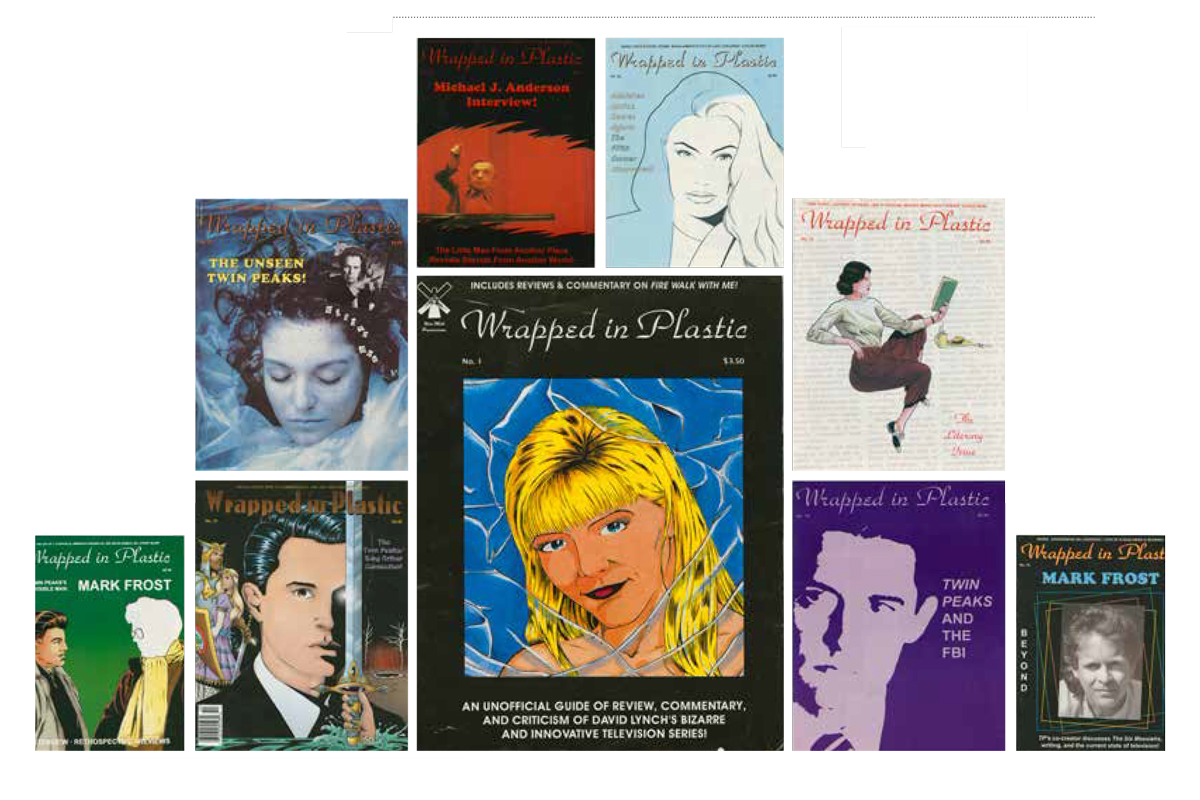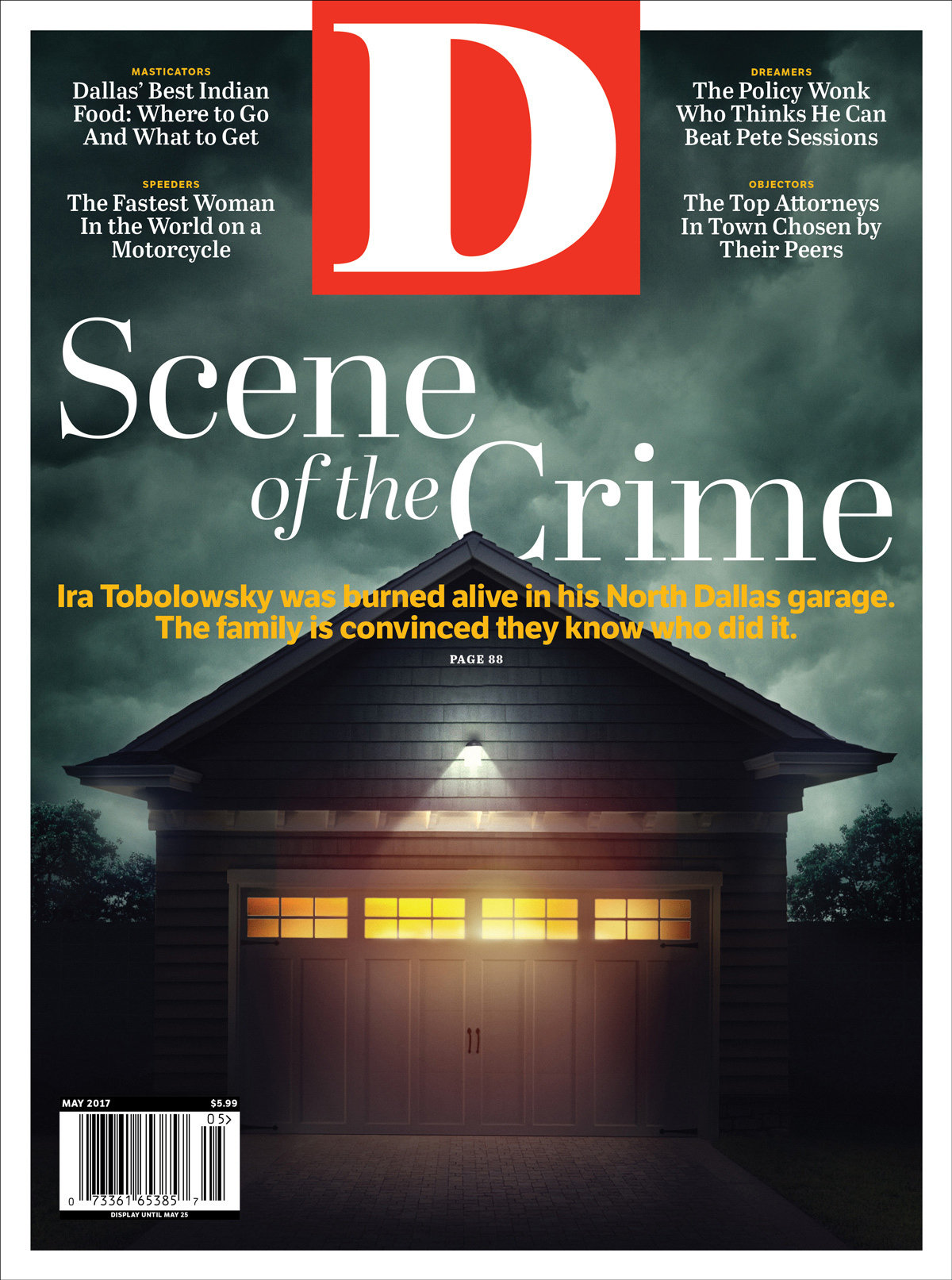On his dining room table, arranged in three neat stacks, is what Howard Miller invited me to his cluttered Plano apartment to see: the entire 75-issue run of Wrapped in Plastic, the now-defunct magazine dedicated to Twin Peaks, David Lynch’s dark and deeply strange television series that aired on ABC for two seasons beginning in 1990. Based out of a modest home in East Arlington, Wrapped in Plastic was published bimonthly between October 1992 and September 2005, lasting 11 years longer than the show that inspired it. Howard has somewhere around 2,000 back issues. But these 75 are his.
“Most are in very fine or mint condition,” he says, shuffling through one of the stacks. He stops and smooths out the corner of a cover. “This one is not really quite in mint condition.”
Howard is a sweet old man with a laugh like a teakettle and Fox News muted on the giant TV hanging on a wall above his desk. Puttering around in his gray plaid snap shirt, the 83-year-old grandfather looks like someone you’d find quietly lingering in an aisle at a Bass Pro Shops, looking at tackle boxes, whiling away his afternoon. He does not seem like the kind of person who would devote even the tiniest fraction of his life to a television show, especially a cult-favorite series that was canceled more than a quarter century ago.

For most of Howard’s life, he wasn’t. But that changed on November 7, 2012, when his son, Craig, died after suffering a heart attack in his sleep. Wrapped in Plastic was Craig’s magazine—he co-founded it and served as editor for the entire run—and so now it is his father’s. For about four years, Howard has been slowly divesting himself of it, one or two issues at a time, putting whatever money that comes in into a trust for Craig’s 13-year-old daughter, Jennifer. It hasn’t been easy; there have been times he’s gone six weeks between orders. (Back issues are available at wrappedinplasticmag.com.) He’s hoping that the imminent return of Twin Peaks will help him finally move the rest of it.
That’s why I’m here. I found Howard because I was looking for Craig, and I was looking for Craig because Wrapped in Plastic was the first thing I thought of when it was announced that Showtime was reviving the series. (It re-debuts on May 21.) Since he had helped keep interest in the show stoked for so long, I wanted to know what Craig thought about its return. Other than Lynch and his co-creator, Mark Frost, and maybe even including them, it is likely that no one had ever considered Twin Peaks more. But when I went to Wrapped in Plastic’s website to find his contact information, I instead found a short note explaining that Craig had passed away, along with Howard’s Hotmail address.
“If Craig was still alive, he would be in his glory about this,” Howard says, “because he could resurrect this magazine.”
On the phone a few days later, Craig’s longtime co-editor, John Thorne, echoes those words. “If anything, I wish Craig were here for this,” he says. “We would certainly be doing the magazine again.”
Craig and John met at the Dallas Fantasy Fair in the summer of 1991, just after Twin Peaks was canceled. John’s reputation preceded him: during the show’s run, he made character charts and trivia games and other Peaks-related ephemera, and his work made its way around the Lone Star Comics chain. When John was invited to speak at a Twin Peaks panel at the Fantasy Fair, Craig was in the audience. He introduced himself afterward and pitched the idea for Wrapped in Plastic right there. The title is a reference to the inciting plot point of the series and one of its first, most iconic images: the discovery of homecoming queen Laura Palmer’s murdered body, naked and swaddled in a tarp. Her blue-green visage loomed over everything that came after—the small-town kooks and quirky FBI agents; the hyper-stylized dream sequences with giants and dwarfs; the genuinely frightening glimpses of abject evil; all that coffee and pie. There was more than enough for a magazine to get into, maybe too much.
“It took about a year while we figured out what to do, what we were allowed to do,” John says.
“Think of it as a nationwide living room where we’re all talking about the television series, the film [the 1992 prequel, Twin Peaks: Fire Walk With Me], and other projects related to Lynch and the various stars,” they wrote in the editors’ note of the first issue, by way of introduction. That was the “what.” The “why” they explained more thoroughly in another note, in the April 1995 issue, on the occasion of the fifth anniversary of the show’s debut: “Twin Peaks is not a failed television experiment in weirdness. It is a successful example of the incredible quality that is possible—though rarely accomplished—in the ridiculed medium of television.”
The “how”—how do you publish a magazine for 13 years based on only 30 episodes and a movie?—is simple: they never ran out of things to talk about. “We really wanted to make an accessible magazine for people who wanted to read something substantive, a critical analysis of Twin Peaks,” John says, “and so I think that drive that we both had kept us focused straight ahead.”
On a nuts-and-bolts level, they had a few advantages. Craig had already self-published a handful of comic-related works prior to Wrapped in Plastic, and his comic-shop connections secured healthy distribution. They received letters from readers in France and Australia, Scotland and Canada, Holland, Finland, Argentina.
Twin Peaks was a show that particularly lent itself to examination. Each frame was full of symbols and allusions (blue roses, black lodges) to be dissected and debated, and even its most minor characters brought with them intricate histories. The infrastructure wasn’t in place yet to handle a show like that. Recap culture didn’t exist. It would be another decade before even the most frivolous of series was instantly over-analyzed.
“There was that nostalgia that couldn’t be immediately fed by the internet back then,” says John Mitchell, who came aboard as a contributing editor around issue No. 30. “Now you have so much social media available to you, web content. Back then, I had to physically go write articles and interview famous people in order to get to know more about the show.”
Eventually, the internet did catch up. Sales—more than 5,000 an issue at their height—slowed. The magazine was just about breaking even. The final installment, billed as a “giant-size ‘hiatus’ issue,” featured interviews with Lynch and Frost. The cover was a still of Kyle MacLachlan’s Agent Dale Cooper, a fitting end since Cooper was the last character to appear on-screen.
At least he was. Who knows what Twin Peaks’ return will bring. The only thing that is certain is that Wrapped in Plastic’s “hiatus” will continue forever. John released a collection of his essays last April (The Essential Wrapped in Plastic: Pathways to Twin Peaks) and is contributing to a new project, Blue Rose Magazine, that centers on the show.
“But it’s not Wrapped in Plastic because it couldn’t be Wrapped in Plastic without Craig,” he says. “He really was the guiding force.”
As for what Craig left behind, Howard doesn’t get to see his granddaughter much anymore—she moved to Ohio with her mother after Craig died, making visits difficult. But she is what has been pushing him forward these last four years: he has spent a lot of time, and not an insignificant amount of money, selling off the remaining issues of Wrapped in Plastic on behalf of his son’s estate, all to help fund Jennifer’s trust. Howard would like to buy them all from the estate himself, just so it’s taken care of. He knows he won’t make his money back, even with the show’s rebirth renewing interest in all things Peaks-related. That doesn’t matter much to him. He only wants to make it easier.
It dawns on me, as Howard stoically discusses his plans, that I slightly misjudged him earlier. He possesses a David Lynchian quality, only it’s not from Twin Peaks. It’s from 1999’s The Straight Story, Lynch’s surprisingly direct and affecting tale of an old man determined to make things right before he dies.
“The nice thing about it is, if I croak—and at 83, I mean, I ain’t gonna live forever,” he says. “If I croak, they can just call somebody and then throw all the stuff out.”






